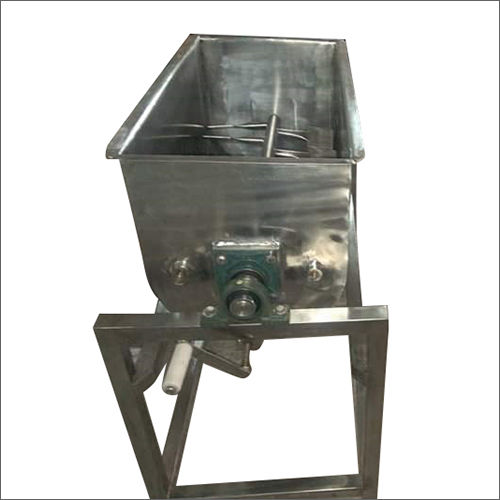
Industrial Ribbon Blender
Product Details:
- Material Stainless Steel
- Computerized No
- Automatic Grade Semi-Automatic
- Cooling System Air Cooling
- Click to View more
Industrial Ribbon Blender Price And Quantity
- 80000 INR/Unit
- 10 Unit
Industrial Ribbon Blender Product Specifications
- Stainless Steel
- Semi-Automatic
- No
- Air Cooling
Industrial Ribbon Blender Trade Information
- Cash Advance (CA)
- 5000 Unit Per Month
- 10 Days
- All India
Product Description
The main characteristics and operation of an industrial ribbon blender are as follows:
1. Construction: The blender normally has a trough composed of corrosion- and contamination-resistant materials, such as stainless steel. The centrally positioned shaft, which is propelled by a motor, is connected to the inner and outer helical ribbons. The ribbons' construction encourages efficient mixing by moving components in opposing directions.
2. Mixing action: The contents of the trough are softly lifted and propelled in various directions as the ribbons rotate, providing a fluidizing and cascading effect. This motion enables the materials to be thoroughly blended and mixed.
3. Ingredients are loaded into the blender manually or with the help of auxiliary machinery like conveyors or feeders through a top-mounted inlet. The blended material is released through a bottom-mounted outlet after mixing is finished, frequently with the help of a gate or valve.
4. Optional features: To improve the mixing process, industrial ribbon blenders can be fitted with extra functions. These could feature mixing time and speed controls, vacuum or pressure capabilities, jackets for heating or cooling, and spray nozzles for adding liquids.
Using an industrial ribbon blender has the following benefits:
- Effective blending: The distinctive ribbon pattern ensures uniformity in the finished product by thoroughly and consistently blending the materials.
- Gentle handling: The ribbons' gentle mixing action reduces product degradation or damage, making it appropriate for goods that are delicate or sensitive.
- Flexibility: Ribbon blenders are capable of processing a variety of dry ingredients, including powders, granules, and even some cohesive substances.
- Scalability: There are many different sizes of industrial ribbon blenders available, from small-scale laboratory units to large-capacity blenders appropriate for industrial manufacturing.
Industrial ribbon blenders are used in a variety of fields where accurate and effective dry material mixing is necessary, including food processing, medicines, chemicals, polymers, and cosmetics.
It's important to keep in mind that ribbon blenders may have special design options and variants to meet various processing needs and guarantee product safety and quality.
FAQ
1. What kind of material is used to create the Industrial Ribbon Blender?
Ans - Stainless steel is used to construct the industrial ribbon blender.
2. How much can an industrial ribbon blender blend?
Ans - An industrial ribbon blender's capacity varies depending on the size and brand, however it typically falls between 25 and 8000 litres.
3. What advantages do industrial ribbon blenders offer?
Ans - Industrial ribbon blenders are used to swiftly and effectively combine dry or wet components of various densities and sizes. Additionally, they can be utilised for deagglomeration, emulsification, and homogenization.
4. How quickly does an industrial ribbon blender operate?
Ans - Depending on the size and brand, an industrial ribbon blender's speed can range from 1 to 30 rpm.
5. Is it simple to clean an industrial ribbon blender?
Ans - Yes. Many Industrial Ribbon Blenders feature quick-release features that make cleaning and maintaining them simple.
 |
ANIKA PLANTS AND EQUIPMENTS INDUSTRIES
All Rights Reserved.(Terms of Use) Developed and Managed by Infocom Network Private Limited. |